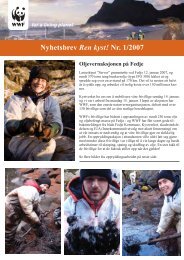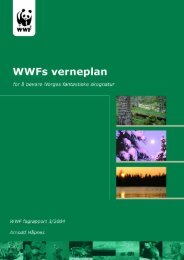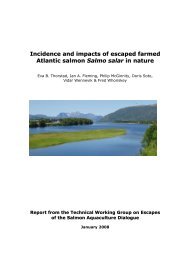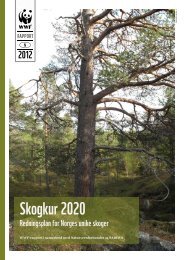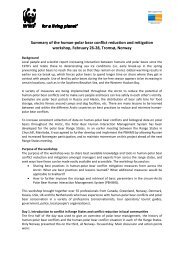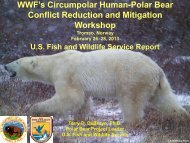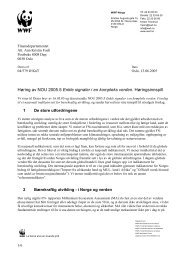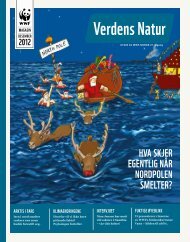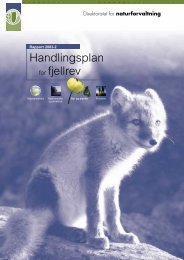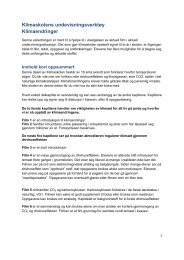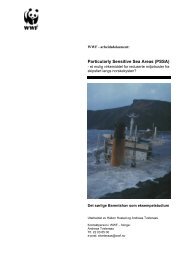Improved livelihoods and governance of natural resources ... - WWF
Improved livelihoods and governance of natural resources ... - WWF
Improved livelihoods and governance of natural resources ... - WWF
Create successful ePaper yourself
Turn your PDF publications into a flip-book with our unique Google optimized e-Paper software.
projects. In the case <strong>of</strong> village payouts, the villages collectively decide how to spend that money <strong>and</strong> have constructed maize storage facilities, school buildings, ceremonial buildings, <strong>and</strong> boreholes, which benefit the whole village <strong>and</strong> which would not have been possible without that money l . It is rare that CBNRM becomes the sole or even primary source <strong>of</strong> income for rural people living on communal l<strong>and</strong>, but rather the CBNRM income or benefits are supplementary to people’s existing <strong>livelihoods</strong> (e.g. farming) <strong>and</strong> are valuable as an additional livelihood diversification strategy li . The community in a registered conservancy retains all the revenue generated from the conservancy, for example from hunting <strong>and</strong> tourism concessions <strong>and</strong>/or community campsites. Since inception <strong>of</strong> the programme in the mid-‐1990s, the attitudes <strong>of</strong> many local communal area residents have changed from resentment <strong>of</strong> the state managed wildlife system where the state received all benefits, whilst the community bore the brunt <strong>of</strong> wildlife in their area, to seeing wildlife as a community asset. Prior to the formation <strong>of</strong> communal conservancies, wildlife was largely regarded as competition to livestock grazing <strong>and</strong>/or despised as a threat to personal assets (i.e., crops, livestock, <strong>and</strong> infrastructure) or even the lives <strong>of</strong> one’s family. Poaching is no longer socially acceptable <strong>and</strong> the presence <strong>of</strong> wildlife is being promoted through participatory community l<strong>and</strong>-‐use zoning processes which create core wildlife (wildlife only) <strong>and</strong> multiple-‐use (wildlife mixed with livestock <strong>and</strong> people) areas in which wildlife numbers are increasing <strong>and</strong> flourishing lii . The change in attitudes is attributable to the increased income <strong>and</strong> other benefits local communities receive from wildlife enterprises <strong>and</strong> management liii . While economic benefits, such as income or employment, are easier to quantify, other important benefits for communities are less quantifiable socio-‐cultural benefits such as participation in decision-‐making <strong>and</strong> authority to make decisions regarding the resource (i.e. empowerment) <strong>and</strong> receipt <strong>of</strong> meat from hunted wildlife to supplement diets. The change in attitude has resulted in improved <strong>governance</strong> over the wildlife <strong>and</strong> a significant recovery <strong>of</strong> wildlife populations, with population trends <strong>of</strong> all species (with the exception <strong>of</strong> lion <strong>and</strong> hyena in some conservancies in the north east <strong>of</strong> Namibia) either stable or increasing. The increasing wildlife populations have resulted in increased tangible benefits for the communities – including cash pay-‐outs, job creation, tourism enterprise development, meat (from trophy hunting) livlv . Increasing wildlife numbers include lions which, in the Kunene have increased from approximately 30 to an estimated 125 by 2008 lvi <strong>and</strong> exp<strong>and</strong>ed their range by several thous<strong>and</strong> square kilometres. Such a recovery was only possible because it was accompanied by a massive recovery <strong>of</strong> the prey base <strong>and</strong> increased tolerance by resident communities. Namibia is the only country in the world where populations <strong>of</strong> black rhino outside protected areas are rising (Weaver, Petersen, Diggle <strong>and</strong> Matongo, 2010). The free-‐roaming black rhino population has more than doubled from 1990 to 2008 in the north-western communal <strong>and</strong> state l<strong>and</strong>s, <strong>and</strong> elephant numbers have increased from approximately 7,000 in 1995 to more than 16,000 by 2008. 12





